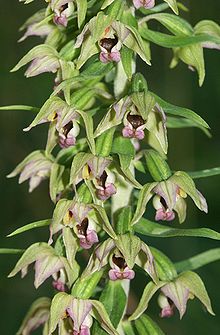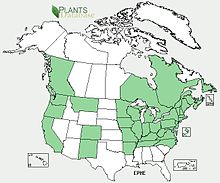Broad-leaved Helleborine
| Broad-leaved helleborine | |
|---|---|
 |
|
| Scientific classification | |
| Kingdom: | Plantae |
| (unranked): | Angiosperms |
| (unranked): | Monocots |
| Order: | Asparagales |
| Family: | Orchidaceae |
| Subfamily: | Epidendroideae |
| Genus: | Epipactis |
| Species: | E. helleborine |
| Binomial name | |
|
Epipactis helleborine (L.) Crantz |
|
 |
|
| Synonyms | |
|
|
Epipactis helleborine, the broad-leaved helleborine, is a terrestrial species of orchid. Its nodding flowers vary from greenish pink to purple, and it prefers shaded woodland environments.
Epipactis helleborine grows to a height of 80 cm and has broad dull green leaves which are strongly ribbed and flat. The flowers are arranged in long drooping racemes with dull green sepals and shorter upper petals. The lower labellum is pale red and is much shorter than the upper petals.
It is widespread across much of Europe and Asia from Portugal to China, as well as northern Africa. In North America, it is widely naturalized mostly in the Northeastern United States, eastern Canada and the Great Lakes Region, but also in scattered locations in other parts of the continent. In the US it is sometimes referred to as the "weed orchid" or "weedy orchid" and is increasingly considered invasive, in areas including Michigan, Wisconsin and the San Francisco Bay Area.
Found in woods and hedge-banksand often, in Belfast, not far from paths near human activity. It was even seen in Moscow, right in the middle of the city, including quite large populations. Eight varieties of Epipactis helleborine in central Europe (Lower Silesia, Poland) had their nectar studied and they were found to contain naturally occurring oxycodone (as well as another narcotic like opioid) in minute amounts.
A rather long list of names have been proposed for subspecies, varieties and forms of Epipactis helleborine, far too many to list here. This is not unusual for such a widespread species. At present (June 2014) only the following are accorded international acceptance:
...
Wikipedia
